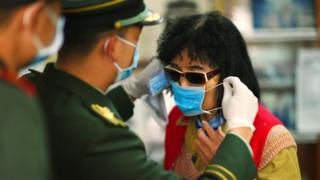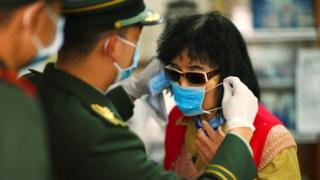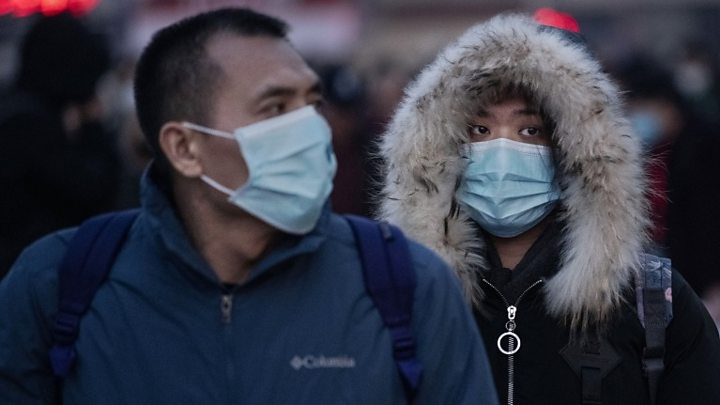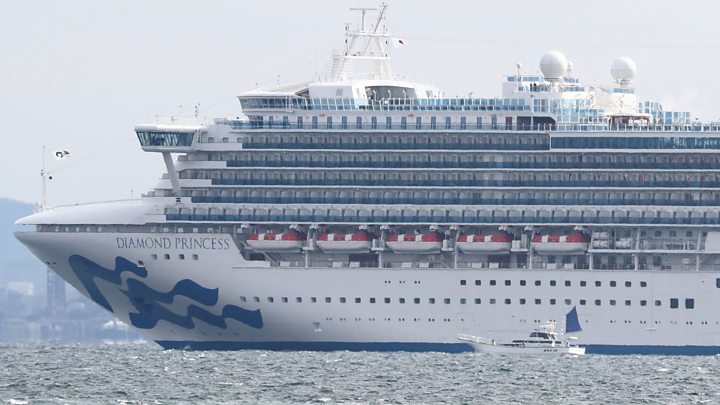Coronavirus: Hong Kong imposes quarantine rules on mainland Chinese
Travellers from mainland China will be isolated for 14 days in new efforts to stem the coronavirus. …

 Image copyright Getty Images
Image copyright Getty Images Hong Kong has begun a mandatory two-week quarantine for anyone arriving from mainland China, in a fresh effort to contain the new coronavirus.
Visitors must isolate themselves in hotel rooms or go to government-run centres, while returning Hong Kong residents must stay inside their homes.
Anyone caught flouting the new rules faces a fine and a prison sentence.
Tens of thousands of travellers queued at the Chinese border city of Shenzhen ahead of the midnight deadline.
Hong Kong has seen 26 confirmed cases of the virus and one person has died. The number of confirmed cases in mainland China stands at 34,546, with 722 deaths.
Outside China, 270 cases have been confirmed in at least 25 countries, with one other fatality – in the Philippines.
Meanwhile, another 41 people on a quarantined cruise ship off Japan have tested positive for the coronavirus, bringing the total number of cases on board to 61.
There was some positive news on Friday when the World Health Organization (WHO) said there had been fewer reported infections in China in the past two days. However, director-general Tedros Adhanom Ghebreyesus cautioned against reading too much into those figures.

Media playback is unsupported on your device
He also told reporters that the outbreak had caused a global shortage of protective medical equipment such as gowns, masks and gloves.
“When supply is short, and demand is high then there could be bad practices like hoarding in order to sell them at higher prices,” he warned, urging suppliers to “uphold the protection of humanity” rather than looking to increase profits.
The WHO also released new data from 17,000 patients that suggested 82% had a mild form of the disease, with 15% considered severe cases and 3% critical.
For most this is a mild infection
This is the clearest detail we’ve had on the spectrum of disease this coronavirus can cause.
It is good news for most people and emphasises that for more than four-in-five, this is a mild infection.
However, that sheer volume of mild cases raises important questions about stopping this epidemic.
The Sars-coronavirus outbreak was relatively easy to stop because patients were often severely ill and easily identified.
Mild cases – which could be mistaken for any other winter bug – are naturally harder to spot.
What we don’t know is how easily people with mild symptoms can spread the new coronavirus.
If mild cases are capable of sustaining this epidemic, then it will be much harder to contain.
It is also worth remembering we still do not know the true number of cases, with some analysts saying there could be 10 times more than official figures suggest.
What’s the situation in Hong Kong?
The semi-autonomous Chinese territory said the mandatory quarantine on anyone entering from the mainland was intended to reduce the spread of the disease.
Tens of thousands of people usually travel from mainland China to Hong Kong every day, although that number fell in recent weeks after the territory closed many of its border points.
This week, thousands of medical workers have been on strike, calling for the border to be fully closed.
Hong Kong authorities said about 11,000 mainland visitors entered the territory on Thursday, up from 8,760 the day before.
What’s happening in mainland China?
There has been widespread anger and grief across China over the death of a doctor who tried to warn about the new coronavirus.
Li Wenliang died after contracting the virus while treating patients in Wuhan – the city in Hubei province that is at the epicentre of the outbreak.
In December he sent a message to fellow medics warning of a virus he thought looked like Sars – another deadly coronavirus. But he was told by police to “stop making false comments” and was investigated for “spreading rumours”.
China’s anti-corruption body said it would open an investigation into “issues involving Dr Li”.
Analysts say it is hard to recall an event in recent years that has triggered as much online grief, rage and mistrust against the Chinese government.
News of Dr Li’s death became the top trending topic on Chinese social media, garnering an estimated 1.5bn views.

Media playback is unsupported on your device
China’s leadership had already faced accusations of downplaying the severity of the virus – and initially trying to keep it secret.
The government has admitted “shortcomings and deficiencies” in its response to the virus, which has now killed 722 people and infected 34,546 in mainland China.
What is the latest on the coronavirus?
- Cruise company Royal Caribbean Cruises says it is banning guests holding Chinese, Hong Kong or Macau passports from boarding its ships. The company has delayed the sailing of its ship Anthem of the Seas from New Jersey after four guests were taken to hospital and tested for coronavirus. The results of the tests are due on Saturday, the company said.
- Uganda’s health ministry has placed more than 100 people in quarantine as a preventative measure against the possible spread of coronavirus
- A third person in the UK has tested positive for the virus, and is believed to have caught it in Singapore
- Singapore has raised its Disease Outbreak Response System Condition (Dorscon) level from yellow to orange. This means that the disease is deemed severe and spreads easily from person to person but has not spread widely and is being contained
- Equatorial Guinea’s president has said the oil-rich country will donate $2m (£1.5m) to aid its “sister nation” China. This is despite the fact that China boasts the world’s second-biggest economy

Media playback is unsupported on your device
Meanwhile, Chinese President Xi Jinping has told his US counterpart Donald Trump that China is “fully confident and capable of defeating the epidemic”. The country has introduced more restrictive measures to try to control the outbreak:
- The capital Beijing has banned group dining for events such as birthdays. Cities including Hangzhou and Nanchang are limiting how many family members can leave home each day
- Hubei province has switched off lifts in high-rise buildings to discourage residents from going outside.




